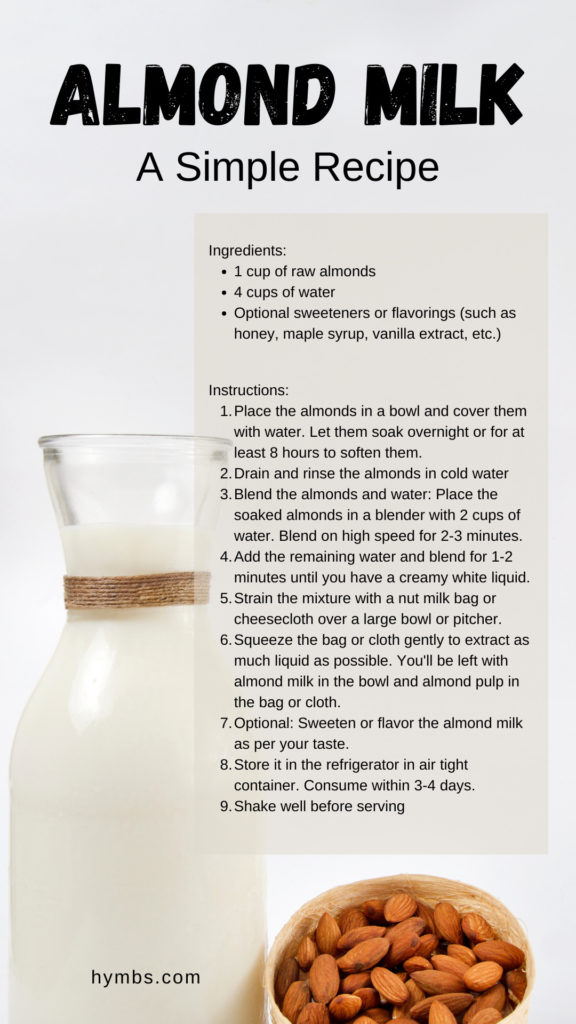Almond milk has become increasingly popular in recent years, especially among those who follow a plant-based diet or are lactose intolerant. While almond milk is a great alternative to traditional dairy milk in many ways, it also has some downsides compared to regular milk.
In this article, we will discuss the pros and cons of using almond milk vs regular milk, to help you decide which one is right for you.
Pros of Almond Milk
Low in calories
Almond milk is a low-calorie alternative to regular milk. One cup of unsweetened almond milk contains only 30-40 calories, compared to 120 calories in one cup of skim milk. This makes almond milk a great option for those who are trying to lose weight or maintain a healthy weight.

Lactose-free
Almond milk is naturally lactose-free, making it a great option for those who are lactose intolerant. Lactose intolerance is a common condition in which the body is unable to digest lactose, a sugar found in milk and dairy products. Symptoms of lactose intolerance include bloating, gas, and diarrhea.
Rich in vitamins and minerals
Almond milk is fortified with essential vitamins and minerals such as calcium, vitamin D, and vitamin E. Calcium is important for strong bones and teeth, while vitamin D helps the body absorb calcium. Vitamin E is an antioxidant that helps protect the body against free radicals, which can cause damage to cells.
Lactose-free
Almond milk is naturally lactose-free, making it a great option for those who are lactose intolerant. Lactose intolerance is a common condition in which the body is unable to digest lactose, a sugar found in milk and dairy products. Symptoms of lactose intolerance include bloating, gas, and diarrhea.
Rich in vitamins and minerals
Almond milk is fortified with essential vitamins and minerals such as calcium, vitamin D, and vitamin E. Calcium is important for strong bones and teeth, while vitamin D helps the body absorb calcium. Vitamin E is an antioxidant that helps protect the body against free radicals, which can cause damage to cells.
Low in saturated fat
Almond milk is low in saturated fat, making it a heart-healthy alternative to regular milk. Saturated fat is a type of fat that is known to increase cholesterol levels and increase the risk of heart disease.
Cons of Almond Milk
Low in protein
Almond milk is low in protein compared to regular milk. One cup of almond milk contains only 1 gram of protein, while one cup of skim milk contains 8 grams of protein. Protein is important for building and repairing muscles, as well as for maintaining a healthy immune system.
Contains additives
Many brands of almond milk contain additives such as sweeteners and thickeners to improve the taste and texture of the milk. Some of these additives may not be healthy, and some people may be allergic or sensitive to them.
May contain carrageenan
Carrageenan is a common additive used in many brands of almond milk to thicken and stabilize the milk. However, some studies have linked carrageenan to inflammation and digestive problems in animals, although the evidence is not yet conclusive in humans.
May not be suitable for infants
Almond milk is not suitable for infants as it does not provide the necessary nutrients for healthy growth and development. Infants require breast milk or formula to ensure they receive the necessary nutrients for their age and stage of development.
Pros of Regular Milk
Rich in protein
Regular milk is a good source of protein, with one cup of skim milk containing 8 grams of protein. Protein is important for building and repairing muscles, as well as for maintaining a healthy immune system.
Rich in calcium
Regular milk is a rich source of calcium, with one cup of milk containing approximately 300 milligrams of calcium. Calcium is important for strong bones and teeth, and it also plays a role in muscle and nerve function.
Natural source of nutrients
Regular milk is a natural source of essential nutrients such as calcium, vitamin D, and vitamin B12. These nutrients are important for overall health and well-being.
Versatile ingredient
Regular milk is a versatile ingredient that can be used in a variety of recipes, from baked goods to sauces and soups. It can also be used to make other dairy products such as cheese and yogurt.
Cons of Regular Milk
High in calories and fat
Regular milk is higher in calories and fat compared to almond milk. One cup of whole milk contains approximately 150 calories and 8 grams of fat, while one cup of skim milk contains approximately 90 calories and 0.5 grams of fat. This makes regular milk a less desirable option for those who are trying to lose weight or maintain a healthy weight.
May cause lactose intolerance
Regular milk contains lactose, a sugar that some people are unable to digest due to lactose intolerance. Symptoms of lactose intolerance include bloating, gas, and diarrhea.
High in saturated fat
Regular milk is high in saturated fat, which can increase cholesterol levels and increase the risk of heart disease. This is especially true for whole milk, which contains more saturated fat compared to skim or low-fat milk.
Not suitable for those with dairy allergies or vegan diets
Regular milk is not suitable for those with dairy allergies or vegan diets, as it is derived from animal milk. It is also not suitable for those who follow a plant-based or vegan diet, as it is considered an animal product.
How to choose between almond milk and regular milk
When choosing between almond milk and regular milk, it ultimately comes down to personal preference and dietary needs. If you are looking for a low-calorie, low-fat, and lactose-free alternative to regular milk, almond milk may be the best choice for you. However, if you are looking for a natural source of essential nutrients such as protein, calcium, and vitamin B12, regular milk may be the better option.
It’s important to note that not all almond milk is created equal. When selecting almond milk, choose unsweetened varieties without additives such as carrageenan. It’s also a good idea to choose brands that are fortified with calcium, vitamin D, and vitamin E. When selecting regular milk, choose low-fat or skim varieties to reduce calorie and fat intake.
In conclusion, both almond milk and regular milk have their pros and cons. While almond milk is a great alternative for those who are lactose intolerant or looking for a low-calorie option, it is low in protein and may contain additives. Regular milk, on the other hand, is a natural source of essential nutrients but may be high in calories, fat, and saturated fat. Ultimately, the choice between almond milk and regular milk comes down to personal preference and dietary needs.
Image by jennyleenaguirre from Pixabay
Water, Milk and More
-

Are Plant-Based Protein Drinks Good Alternative to Milk?
With the rising popularity of plant-based diets and the growing awareness of environmental and health concerns associated with dairy consumption, plant-based protein drinks have emerged as a prominent alternative to traditional milk. Derived from various plant sources like soy, almond, pea, and hemp, these beverages are promoted for their nutritional content, ethical appeal, and environmental…
-

Why Herbal Teas and Which Are the Best for Wellness
-

Coconut Water vs. Sports Drinks: Which One is Better for You?
-

Drink Coconut Water for Max Hydration and Energy
-

How to Support Fluid Balance with Natural Diuretics
-

The Impact of Coffee on Hydration: Myths vs Facts
-

Symptoms of Dehydration and How to beat it









Leave a Reply